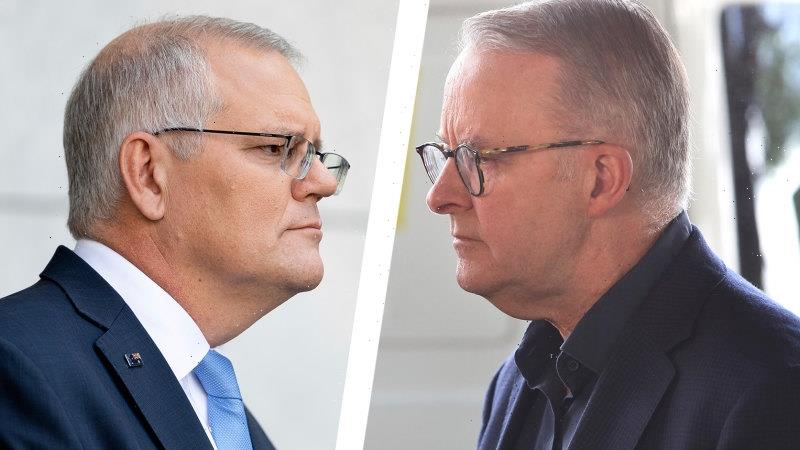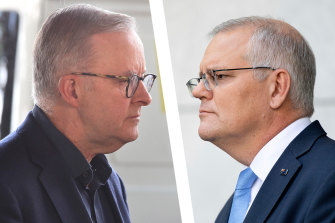Scott Morrison will go to the May 21 election asking Australians to stick with his “tried and tested” government and its economic record against his challenger Anthony Albanese’s promise that it’s time to deliver a sweeping agenda for change.
The Prime Minister launched the six-week election campaign by urging voters to back his government on its record in lifting growth and cutting unemployment while the Labor leader pledged a better future and a “sense of optimism” including a boost to wages.
Anthony Albanese and Scott Morrison will face off at the polls on May 21. Credit:James Alcock/Alex Ellinghausen
The campaign begins with the Coalition on the defensive in crucial electorates across the country based on new analysis showing it has suffered a 7 per cent swing since the last election, enough to sweep it from power and install Albanese in The Lodge.
The quarterly analysis from the Resolve Political Monitor, to be released on Monday, reveals the threat to the Coalition in Queensland and Western Australia at the start of the campaign when Morrison is relying on a pitch to regional voters – backed by billions of dollars in budget spending – to gain ground and block Albanese from gaining a majority.
Mr Morrison asked Australians to back him to manage the economy, national security and the recovery from the pandemic in a pitch that relied heavily on a warning to voters about the risk of supporting Labor.
“Our government is not perfect, we’ve never claimed to be, but we are upfront,” he said.
“And you may see some flaws, but you can also see what we have achieved for Australia in incredibly difficult times.”
Mr Albanese countered with pledges to act on climate change, support higher wages, increase spending on aged care and set up a reconstruction fund to support local manufacturing, but he also made it clear he expected a scare campaign against Labor.
“Fear can be a powerful emotion and there will be a bit of that over the next six weeks, I expect, but I want to appeal to Australians’ sense of optimism and hope for a better future,” he said.
“I won’t go missing when the going gets tough.”
Morrison launched the campaign after flying from Sydney to Canberra on Sunday morning to visit Governor-General David Hurley at Government House in Yarralumla to ask him to dissolve Parliament and set May 21 as the date for Australians to cast their ballots.
The government strategy takes the election to the last possible day for votes to be cast in a standard half-Senate election on a Saturday, maximising the length of the formal campaign in the hope Albanese will crumble under pressure.
“It is a choice between a strong economy and a Labor opposition that would weaken it,” Morrison said.
Morrison’s advisers have been frustrated for months at what they regard as a lack of scrutiny of Albanese and his policies, but their attempts to shine a spotlight on the Labor leader have been undone by the disunity within the Liberals including attacks on the Prime Minister’s character.
The government’s challenges were highlighted on Sunday when Morrison was asked about the status of former education minister Alan Tudge, who stood aside earlier this year over questions about his relationship with a former press secretary, Rachelle Miller.
Asked if Tudge would be restored to federal cabinet, Mr Morrison responded by saying “Alan Tudge is still in my cabinet” and countering the assumption the minister had been sidelined.
Morrison is preparing to name a new minister to the health portfolio this week so Australians will know who will take over the post from Health Minister Greg Hunt, who is leaving Parliament at this election.
Asked about his own intentions, Mr Morrison confirmed he would serve the full term of Parliament if the government was returned.
On his policies, Morrison emphasised the tax relief offered in the federal budget as well as benefits for small business owners while pointing to the unemployment rate – forecast to be 3.75 per cent later this year, the lowest in 48 years – as proof of results.
He named government spending on roads, railways, renewable energy and new dams as key priorities as well as the “biggest rebuilding” of the Australian Defence Force since World War II.
“It’s a choice between a strong and tested government team that has demonstrated our ability to make difficult and tough choices in tough times and a Labor opposition who has been so focused on politics over these past few years that they still can’t tell you what they’d do, who they are, or what they believe in and what they stand for,” he said.
“It’s a choice between a government you know and a Labor opposition that you don’t.”
Albanese bristled at questions on Sunday that suggested he had not unveiled enough of his policies, pointing to the climate change policy he outlined last December with estimates it would support 604,000 jobs by 2030. The policy requires spending $24 billion on new infrastructure while capping greenhouse gas emissions at large enterprises.
Albanese sought to remind voters of Mr Morrison’s attack on Labor at the last election for setting a target to encourage the purchase of electric vehicles.
“If you fear the present you have no chance of shaping the future,” he said.
Assuring voters he had an agenda for the next term of Parliament, Albanese listed policies such as a $2.5 billion aged care plan to hire more nurses and lift standards, a childcare policy to increase rebates for families, a national integrity commission with stronger powers than the government’s model, a $10 billion fund to invest in affordable housing and a reconstruction fund for manufacturing.
He emphasised industrial relations as a field where Labor would act in government to encourage the Fair Work Commission to set higher pay rates.
“We will have a policy of lifting peoples’ wages through the changes that we announced almost two years ago for industrial relations,” he said.
“Making sure that secure work is an objective in the Fair Work Act. Properly defining casualisation. Having same job, same pay. Making wage theft the crime. Closing the gender pay gap.
“We have outlined a series of policies for the election. Mr Morrison has not outlined any agenda for another term.”
The campaign has already been under way before its official announcement with both leaders crossing the country over the past week.
Morrison has visited the Labor seats of Corio and McEwen in Victoria, both just outside Melbourne, as well as Lyons in Tasmania, Parramatta in western Sydney and Dobell on the central coast of NSW. His regional visit in NSW also took in three Labor seats in the Hunter Valley – Hunter, Shortland and Paterson – but was overshadowed by strong criticism from a disability support pensioner during a visit to a tavern outside Newcastle.
Morrison also held media events over the past week in Liberal electorates including Chisholm in Melbourne – the government’s most marginal seat – as well as Bass in Tasmania, Banks in southern Sydney and Robertson on the central coast of NSW.
Albanese has made several visits to the South Australian seat of Boothby, which is held by the Liberals but is the Labor Party’s key target in that state, as well as holding media events in Reid in western Sydney, Hasluck in Perth (held by Indigenous Australians Minister Ken Wyatt) and the northern Brisbane seats of Longman and Dickson (held by Defence Minister Peter Dutton).
The Labor leader made a visit to defend the Brisbane seat of Lilley, the party’s most marginal seat in Queensland. His visit to the NSW central coast took in the neighbouring seats of Dobell (held by Labor) and Robertson (held by the Liberals).
Jacqueline Maley cuts through the noise of the federal election campaign with news, views and expert analysis. Sign up to our Australia Votes 2022 newsletter here.
Most Viewed in Politics
From our partners
Source: Read Full Article

